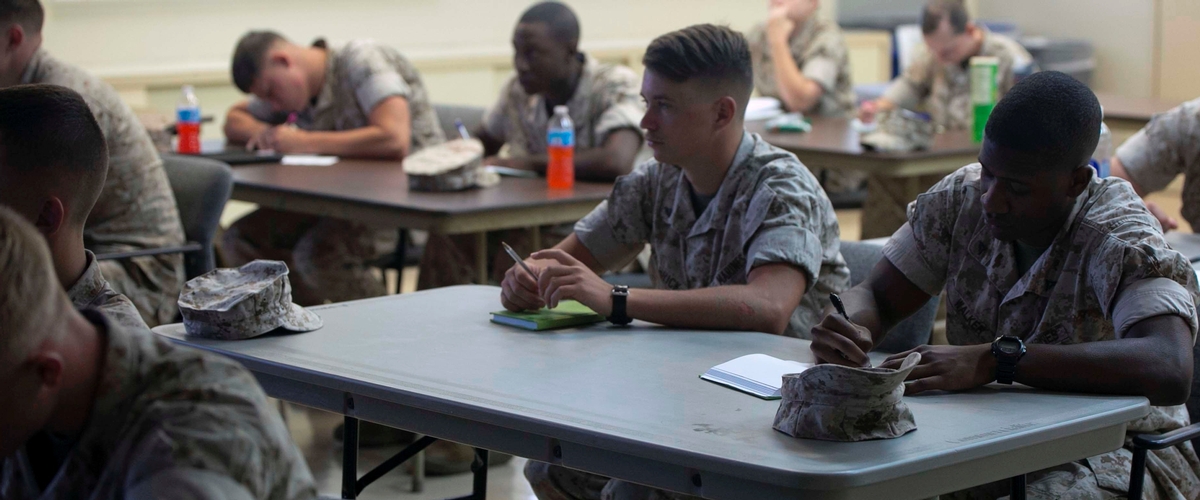Everything You Need to Know About the Voluntary Education Program

Are you thinking of getting a college degree? With your military training and experience you may already be part way there. The Marine Corps’ Voluntary Education (VOLED) Program provides educational services and programs that offer the Marine Corps community the opportunity to complete undergraduate and graduate degrees via both traditional and online methods through a network of regionally accredited colleges and universities. If you are not familiar with the Voluntary Education Program, our article Turn Your Marine Corps Experience Into College Credits is a good place to start.
Now that you have decided that the Voluntary Education Program is for you, what’s the next step?
Step 1: Obtain Joint Service Transcript copy and ensure it reflects training and education completed to date.
Step 2: Contact an education services officer at an installation education center. He or she will assist in calculating ACE-recommended credits and in selecting a home college and degree program.
Step 3: Choose a degree program and a home college. In-classroom courses or distance learning also may be chosen.
Step 4: Submit a Student Agreement to the home college and a request for TA to the installation education center.
Step 5: Take CLEP/DANTES exams and college courses.
Recommendations
Whether serving for two months or 20 years, there are a few things recommended for all Marines over the course of their careers.
Go early and go often.
Most units require Marines to go to the installation education center as part of their check-in process. Rather than simply getting a signature on a check-in sheet, print out a copy of the JST and sit down with an education services officer to discuss education goals. Even if Marines initially have no desire to go to college, it is always good to find out how many college credits they have and what degree options are available.
Keep a record.
Every Marine should establish a place to collect and store all education-related documents (school applications, transcripts, TA, written work, JST, course certificates, etc.). It is never too early to start tracking work and college credits. Information should be taken to installation education centers at least once a year so JSTs can be verified and updated to ensure credits are adding up to achieve education goals.
Ask questions.
Don’t be afraid to ask if a course is American Council on Education (ACE) evaluated and how many credits it is worth. If currently enrolled in a college or university, consult academic counselors or registrars to determine if the college will accept transfer credits for particular work-related courses.
Do the research.
Check out the websites included in this article to see what schools and degree plans are available. Looking at those prior to meeting with an education services officer will greatly facilitate achieving education and career goals. It also will help determine what questions to ask.
To learn more about the Voluntary Education Program, click here.
This content was adapted from an article originally published in Leatherneck Magazine.
Now that you have decided that the Voluntary Education Program is for you, what’s the next step?
Step 1: Obtain Joint Service Transcript copy and ensure it reflects training and education completed to date.
Step 2: Contact an education services officer at an installation education center. He or she will assist in calculating ACE-recommended credits and in selecting a home college and degree program.
Step 3: Choose a degree program and a home college. In-classroom courses or distance learning also may be chosen.
Step 4: Submit a Student Agreement to the home college and a request for TA to the installation education center.
Step 5: Take CLEP/DANTES exams and college courses.
Recommendations
Whether serving for two months or 20 years, there are a few things recommended for all Marines over the course of their careers.
Go early and go often.
Most units require Marines to go to the installation education center as part of their check-in process. Rather than simply getting a signature on a check-in sheet, print out a copy of the JST and sit down with an education services officer to discuss education goals. Even if Marines initially have no desire to go to college, it is always good to find out how many college credits they have and what degree options are available.
Keep a record.
Every Marine should establish a place to collect and store all education-related documents (school applications, transcripts, TA, written work, JST, course certificates, etc.). It is never too early to start tracking work and college credits. Information should be taken to installation education centers at least once a year so JSTs can be verified and updated to ensure credits are adding up to achieve education goals.
Ask questions.
Don’t be afraid to ask if a course is American Council on Education (ACE) evaluated and how many credits it is worth. If currently enrolled in a college or university, consult academic counselors or registrars to determine if the college will accept transfer credits for particular work-related courses.
Do the research.
Check out the websites included in this article to see what schools and degree plans are available. Looking at those prior to meeting with an education services officer will greatly facilitate achieving education and career goals. It also will help determine what questions to ask.
To learn more about the Voluntary Education Program, click here.
This content was adapted from an article originally published in Leatherneck Magazine.
Last Updated: 27 Jul 2021